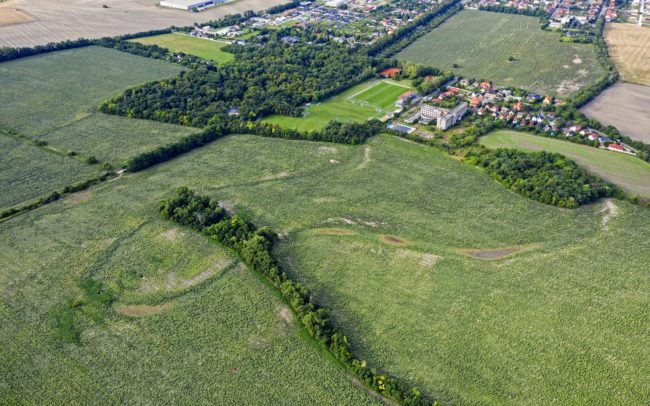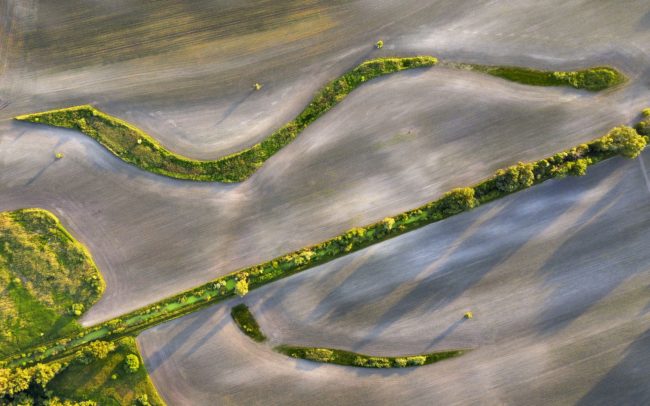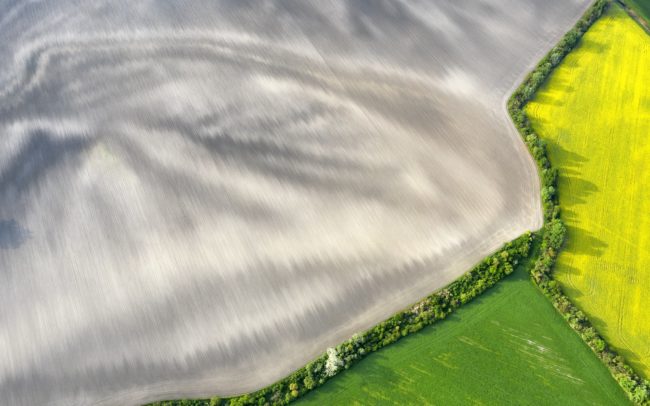
The former rivers of Great Rye Island are isles in the agricultural landscape. These preserved river bends with reeds, bushes and trees are very important and species-rich habitats simply because of their huge size. Their right to exist is not in question, because they are worth a treasure. Their future is all the more uncertain because we are unable to see their value. While rivers used to be natural parts of the landscape, with which people could live together, the existence of their remains today is uncertain, as they are much more in the way of human interests. It is feared that the drying of the environment and the desire for arable land will sooner or later wipe them off the face of the earth. Great Rye Island, Slovakia.

We often think about wetlands as a big places. This formation was left from the time of the liquidation of ancient branches, backwaters - a large delta - of Danube river in the past. Small areas like this, with scattered marshes, reed and trees are extremely important for the wild animals, plants and for biodiversity when there is a cultivated land everywhere around. Great Rye Island, Slovakia

Hundreds or even thousands of european tree frogs have developed in the village of Sap, in a depression the size of a football field filled with water. It is a nice example of how the remains of former riverbeds can serve as miniature biodiversity hotspots even in the middle of a settlement. Its dominant plant is purple loosetrife, and its forest provides an ideal habitat for other species as well. Several species of bumblebees, bees, flies, hoverflies, dragonflies, and ladybugs stayed at the height of the plant's flowers. Lower down, its stems and leaves were occupied by tiny tree frogs, in exceptionally high density. A single plant species can provide excellent conditions for a multitude of animal species, which divide the space between them very nicely. And it is not bad to have such a wet habitat providing fresh microclimate in the middle of a village, during the drying climate.

Driving on the road connecting settlements of Mad and Dolný Bar, or on road 63 between Dolný Bar and Dolný Štál, you might not notice anything special in the landscape. However, viewed from above, as the world expands, the flat landscape becomes very diverse. You will immediately see that one shape completely dominates and defines the surroundings. The former river in this part was called Hann (Han). Its forested and bushy line, rich in reeds, meanders thickly - this is one of the most striking single-use rivers in the Csallóköz. At the edge of Dolný Štál, the waterways of the past and the paved roads of the present cross each other, and even the superficial observer can get an insight into the secrets of the former. Great Rye Island, Slovakia.

The former rivers of Great Rye Island are isles in the agricultural landscape. These preserved river bends with reeds, bushes and trees are very important and species-rich habitats simply because of their huge size. Their right to exist is not in question, because they are worth a treasure. Their future is all the more uncertain because we are unable to see their value. While rivers used to be natural parts of the landscape, with which people could live together, the existence of their remains today is uncertain, as they are much more in the way of human interests. It is feared that the drying of the environment and the desire for arable land will sooner or later wipe them off the face of the earth. Great Rye Island, Slovakia.

Picture of former Danube meander maybe wake us up how important is to bring back life to the agricultural countryside when we want to live in diverse and rich land. Revitalisation of small pieces of land may cause a positive impact, it is a way how to reach the former biodiversity of the areas changed by human activity. Great Rye Island, Slovakia

The former rivers of Great Rye Island are isles in the agricultural landscape. These preserved river bends with reeds, bushes and trees are very important and species-rich habitats simply because of their huge size. Their right to exist is not in question, because they are worth a treasure. Their future is all the more uncertain because we are unable to see their value. While rivers used to be natural parts of the landscape, with which people could live together, the existence of their remains today is uncertain, as they are much more in the way of human interests. It is feared that the drying of the environment and the desire for arable land will sooner or later wipe them off the face of the earth. Great Rye Island, Slovakia.

Satellite images also show that the landscape between Dolný Bar and Dolný Štál is dominated by a meandering line. Yes, the horizontal waves of the former river. The part that crosses the Class I road 63 has remained swampy, overgrown with reeds and forests. It doesn't seem to have been tampered with since man turned off the faucets that supplied it with water. It is slowly overgrown with vegetation, the succession works. This also happens when a natural stream crosses its meanders, it is the natural fate of dead arms thus formed. They dry up, transform, become overgrown with reeds and then forest. Over the centuries, the former riverbed passes through several phases, successive biotopes. Next to it, the small white dots visible on the canola field are swans, which mainly fed on canola in the winter. Great Rye Island, Slovakia.
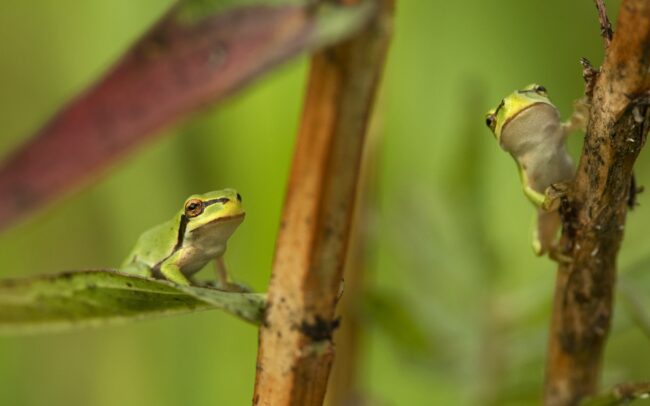
Hundreds or even thousands of european tree frogs have developed in the village of Sap, in a depression the size of a football field filled with water. It is a nice example of how the remains of former riverbeds can serve as miniature biodiversity hotspots even in the middle of a settlement. Its dominant plant is purple loosetrife, and its forest provides an ideal habitat for other species as well. Several species of bumblebees, bees, flies, hoverflies, dragonflies, and ladybugs stayed at the height of the plant's flowers. Lower down, its stems and leaves were occupied by tiny tree frogs, in exceptionally high density. A single plant species can provide excellent conditions for a multitude of animal species, which divide the space between them very nicely. And it is not bad to have such a wet habitat providing fresh microclimate in the middle of a village, during the drying climate.

The former rivers of Great Rye Island are isles in the agricultural landscape. These preserved river bends with reeds, bushes and trees are very important and species-rich habitats simply because of their huge size. Their right to exist is not in question, because they are worth a treasure. Their future is all the more uncertain because we are unable to see their value. While rivers used to be natural parts of the landscape, with which people could live together, the existence of their remains today is uncertain, as they are much more in the way of human interests. It is feared that the drying of the environment and the desire for arable land will sooner or later wipe them off the face of the earth. Great Rye Island, Slovakia.

Driving on the road connecting settlements of Mad and Dolný Bar, or on road 63 between Dolný Bar and Dolný Štál, you might not notice anything special in the landscape. However, viewed from above, as the world expands, the flat landscape becomes very diverse. You will immediately see that one shape completely dominates and defines the surroundings. The former river in this part was called Hann (Han). Its forested and bushy line, rich in reeds, meanders thickly - this is one of the most striking single-use rivers in the Csallóköz. At the edge of Dolný Štál, the waterways of the past and the paved roads of the present cross each other, and even the superficial observer can get an insight into the secrets of the former. Great Rye Island, Slovakia.

We often think about wetlands as a big places. This formation was left from the time of the liquidation of ancient branches, backwaters - a large delta - of Danube river in the past. Small areas like this, with scattered marshes, reed and trees are extremely important for the wild animals, plants and for biodiversity when there is a cultivated land everywhere around. Great Rye Island, Slovakia

We often think about wetlands as a big places. This formation was left from the time of the liquidation of ancient branches, backwaters - a large delta - of Danube river in the past. Small areas like this, with scattered marshes, reed and trees are extremely important for the wild animals, plants and for biodiversity when there is a cultivated land everywhere around. Great Rye Island, Slovakia

Ancient meander of Danube-branch was once a part of river´s large delta, created in Carpathian basin. Now the former river line looks like a strip of nature and life in agricultural land. Places like this are often the only and last refuges for animals. There is also a permanent water - a small lake, surrounded by trees. Great Rye Island, Slovakia

Driving on the road connecting settlements of Mad and Dolný Bar, or on road 63 between Dolný Bar and Dolný Štál, you might not notice anything special in the landscape. However, viewed from above, as the world expands, the flat landscape becomes very diverse. You will immediately see that one shape completely dominates and defines the surroundings. The former river in this part was called Hann (Han). Its forested and bushy line, rich in reeds, meanders thickly - this is one of the most striking single-use rivers in the Csallóköz. At the edge of Dolný Štál, the waterways of the past and the paved roads of the present cross each other, and even the superficial observer can get an insight into the secrets of the former. Great Rye Island, Slovakia.

According to the evidence of 19th century maps, Lake Sísára was one of the most extensive water biotopes of the former Golden Garden. The shallows, extending to the north of the village of Vrakúň, were connected to several streams. They fed it or drained it, such as this winding arm near the village. Great Rye Island, Slovakia

Picture of former Danube meander maybe wake us up how important is to bring back life to the agricultural countryside when we want to live in diverse and rich land. Revitalisation of small pieces of land may cause a positive impact, it is a way how to reach the former biodiversity of the areas changed by human activity. Great Rye Island, Slovakia

The former rivers of Great Rye Island are isles in the agricultural landscape. These preserved river bends with reeds, bushes and trees are very important and species-rich habitats simply because of their huge size. Their right to exist is not in question, because they are worth a treasure. Their future is all the more uncertain because we are unable to see their value. While rivers used to be natural parts of the landscape, with which people could live together, the existence of their remains today is uncertain, as they are much more in the way of human interests. It is feared that the drying of the environment and the desire for arable land will sooner or later wipe them off the face of the earth. Great Rye Island, Slovakia.

Driving on the road connecting settlements of Mad and Dolný Bar, or on road 63 between Dolný Bar and Dolný Štál, you might not notice anything special in the landscape. However, viewed from above, as the world expands, the flat landscape becomes very diverse. You will immediately see that one shape completely dominates and defines the surroundings. The former river in this part was called Hann (Han). Its forested and bushy line, rich in reeds, meanders thickly - this is one of the most striking single-use rivers in the Csallóköz. At the edge of Dolný Štál, the waterways of the past and the paved roads of the present cross each other, and even the superficial observer can get an insight into the secrets of the former. Great Rye Island, Slovakia.

Hundreds or even thousands of european tree frogs have developed in the village of Sap, in a depression the size of a football field filled with water. It is a nice example of how the remains of former riverbeds can serve as miniature biodiversity hotspots even in the middle of a settlement. Its dominant plant is purple loosetrife, and its forest provides an ideal habitat for other species as well. Several species of bumblebees, bees, flies, hoverflies, dragonflies, and ladybugs stayed at the height of the plant's flowers. Lower down, its stems and leaves were occupied by tiny tree frogs, in exceptionally high density. A single plant species can provide excellent conditions for a multitude of animal species, which divide the space between them very nicely. And it is not bad to have such a wet habitat providing fresh microclimate in the middle of a village, during the drying climate.
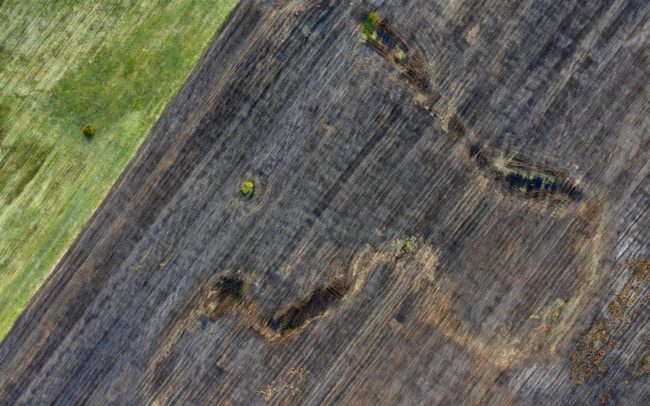
According to the evidence of 19th century maps, Lake Sísára was one of the most extensive water biotopes of the former Golden Garden. The shallows, extending to the north of the village of Vrakúň, were connected to several streams. They fed it or drained it, such as this winding arm near the village. Great Rye Island, Slovakia

Driving on the road connecting settlements of Mad and Dolný Bar, or on road 63 between Dolný Bar and Dolný Štál, you might not notice anything special in the landscape. However, viewed from above, as the world expands, the flat landscape becomes very diverse. You will immediately see that one shape completely dominates and defines the surroundings. The former river in this part was called Hann (Han). Its forested and bushy line, rich in reeds, meanders thickly - this is one of the most striking single-use rivers in the Csallóköz. At the edge of Dolný Štál, the waterways of the past and the paved roads of the present cross each other, and even the superficial observer can get an insight into the secrets of the former. Great Rye Island, Slovakia.

The former rivers of Great Rye Island are isles in the agricultural landscape. These preserved river bends with reeds, bushes and trees are very important and species-rich habitats simply because of their huge size. Their right to exist is not in question, because they are worth a treasure. Their future is all the more uncertain because we are unable to see their value. While rivers used to be natural parts of the landscape, with which people could live together, the existence of their remains today is uncertain, as they are much more in the way of human interests. It is feared that the drying of the environment and the desire for arable land will sooner or later wipe them off the face of the earth. Great Rye Island, Slovakia.

Hundreds or even thousands of european tree frogs have developed in the village of Sap, in a depression the size of a football field filled with water. It is a nice example of how the remains of former riverbeds can serve as miniature biodiversity hotspots even in the middle of a settlement. Its dominant plant is purple loosetrife, and its forest provides an ideal habitat for other species as well. Several species of bumblebees, bees, flies, hoverflies, dragonflies, and ladybugs stayed at the height of the plant's flowers. Lower down, its stems and leaves were occupied by tiny tree frogs, in exceptionally high density. A single plant species can provide excellent conditions for a multitude of animal species, which divide the space between them very nicely. And it is not bad to have such a wet habitat providing fresh microclimate in the middle of a village, during the drying climate.

The former rivers of Great Rye Island are isles in the agricultural landscape. These preserved river bends with reeds, bushes and trees are very important and species-rich habitats simply because of their huge size. Their right to exist is not in question, because they are worth a treasure. Their future is all the more uncertain because we are unable to see their value. While rivers used to be natural parts of the landscape, with which people could live together, the existence of their remains today is uncertain, as they are much more in the way of human interests. It is feared that the drying of the environment and the desire for arable land will sooner or later wipe them off the face of the earth. Great Rye Island, Slovakia.

Driving on the road connecting settlements of Mad and Dolný Bar, or on road 63 between Dolný Bar and Dolný Štál, you might not notice anything special in the landscape. However, viewed from above, as the world expands, the flat landscape becomes very diverse. You will immediately see that one shape completely dominates and defines the surroundings. The former river in this part was called Hann (Han). Its forested and bushy line, rich in reeds, meanders thickly - this is one of the most striking single-use rivers in the Csallóköz. At the edge of Dolný Štál, the waterways of the past and the paved roads of the present cross each other, and even the superficial observer can get an insight into the secrets of the former. Great Rye Island, Slovakia.

Although long dead because of human activity, which transform its habitat to agricultural land, the unearthly beauty of this ancient riverbed seems to defy time. Not even a half-kilometer perspective can picture the curves it once had. Lines of roe deer marks scratch its pastel colors. Great Rye Island, Slovakia
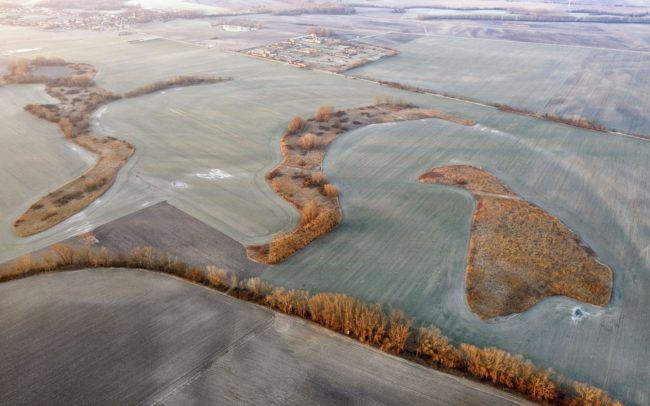
The former rivers of Great Rye Island are isles in the agricultural landscape. These preserved river bends with reeds, bushes and trees are very important and species-rich habitats simply because of their huge size. Their right to exist is not in question, because they are worth a treasure. Their future is all the more uncertain because we are unable to see their value. While rivers used to be natural parts of the landscape, with which people could live together, the existence of their remains today is uncertain, as they are much more in the way of human interests. It is feared that the drying of the environment and the desire for arable land will sooner or later wipe them off the face of the earth. Great Rye Island, Slovakia.

Picture of former Danube meander maybe wake us up how important is to bring back life to the agricultural countryside when we want to live in diverse and rich land. Revitalisation of small pieces of land may cause a positive impact, it is a way how to reach the former biodiversity of the areas changed by human activity. Great Rye Island, Slovakia

Driving on the road connecting settlements of Mad and Dolný Bar, or on road 63 between Dolný Bar and Dolný Štál, you might not notice anything special in the landscape. However, viewed from above, as the world expands, the flat landscape becomes very diverse. You will immediately see that one shape completely dominates and defines the surroundings. The former river in this part was called Hann (Han). Its forested and bushy line, rich in reeds, meanders thickly - this is one of the most striking single-use rivers in the Csallóköz. At the edge of Dolný Štál, the waterways of the past and the paved roads of the present cross each other, and even the superficial observer can get an insight into the secrets of the former. Great Rye Island, Slovakia.

The former rivers of Great Rye Island are isles in the agricultural landscape. These preserved river bends with reeds, bushes and trees are very important and species-rich habitats simply because of their huge size. Their right to exist is not in question, because they are worth a treasure. Their future is all the more uncertain because we are unable to see their value. While rivers used to be natural parts of the landscape, with which people could live together, the existence of their remains today is uncertain, as they are much more in the way of human interests. It is feared that the drying of the environment and the desire for arable land will sooner or later wipe them off the face of the earth. Great Rye Island, Slovakia.

Hundreds or even thousands of european tree frogs have developed in the village of Sap, in a depression the size of a football field filled with water. It is a nice example of how the remains of former riverbeds can serve as miniature biodiversity hotspots even in the middle of a settlement. Its dominant plant is purple loosetrife, and its forest provides an ideal habitat for other species as well. Several species of bumblebees, bees, flies, hoverflies, dragonflies, and ladybugs stayed at the height of the plant's flowers. Lower down, its stems and leaves were occupied by tiny tree frogs, in exceptionally high density. A single plant species can provide excellent conditions for a multitude of animal species, which divide the space between them very nicely. And it is not bad to have such a wet habitat providing fresh microclimate in the middle of a village, during the drying climate.

One-time riverbed in agricultural land. It was meandering through the region of southwestern Slovakia before the human activity which changes the land for own use centuries ago. The water of the river has been forced to the canals, its marshes have been dried. Lines of roe deer marks scratch its pastel colors. Great Rye Island, Slovakia

The former rivers of Great Rye Island are isles in the agricultural landscape. These preserved river bends with reeds, bushes and trees are very important and species-rich habitats simply because of their huge size. Their right to exist is not in question, because they are worth a treasure. Their future is all the more uncertain because we are unable to see their value. While rivers used to be natural parts of the landscape, with which people could live together, the existence of their remains today is uncertain, as they are much more in the way of human interests. It is feared that the drying of the environment and the desire for arable land will sooner or later wipe them off the face of the earth. Great Rye Island, Slovakia.

Driving on the road connecting settlements of Mad and Dolný Bar, or on road 63 between Dolný Bar and Dolný Štál, you might not notice anything special in the landscape. However, viewed from above, as the world expands, the flat landscape becomes very diverse. You will immediately see that one shape completely dominates and defines the surroundings. The former river in this part was called Hann (Han). Its forested and bushy line, rich in reeds, meanders thickly - this is one of the most striking single-use rivers in the Csallóköz. At the edge of Dolný Štál, the waterways of the past and the paved roads of the present cross each other, and even the superficial observer can get an insight into the secrets of the former. Great Rye Island, Slovakia.

There is a pond near my home, hidden among the trees. It can also be seen in the photo, it is bruised on the left side. According to my childhood memories, it was the furthest point of my wanderings, my end of the world. Only an aerial view will show that it is actually the deeper part of the former dead branch, and is almost always filled with water. But also the other parts of this strip of the former river are laid low, in the depression most of the crops will not be taken. According to the testimony of old maps, it has been farmed in a different way than the surrounding area for several centuries, thanks to which the original shape of the river branch has been preserved. Great Rye Island, Slovakia

Stormy clouds are reflected in the water of this little marsh. It provides permanent water in one of the Danube´s dried branch. For animals, the lake is a small island, an oasis of peace in a cultural landscape. Waterfowl are abundant on its water and fallen trunks, older trees and trees marked by a beavers on its banks are occupied by woodpeckers and other forest birds, roe deers are hidden in the bushes at its edge. Great Rye Island, Slovakia

The former rivers of Great Rye Island are isles in the agricultural landscape. These preserved river bends with reeds, bushes and trees are very important and species-rich habitats simply because of their huge size. Their right to exist is not in question, because they are worth a treasure. Their future is all the more uncertain because we are unable to see their value. While rivers used to be natural parts of the landscape, with which people could live together, the existence of their remains today is uncertain, as they are much more in the way of human interests. It is feared that the drying of the environment and the desire for arable land will sooner or later wipe them off the face of the earth. Great Rye Island, Slovakia.

The former rivers of Great Rye Island are isles in the agricultural landscape. These preserved river bends with reeds, bushes and trees are very important and species-rich habitats simply because of their huge size. Their right to exist is not in question, because they are worth a treasure. Their future is all the more uncertain because we are unable to see their value. While rivers used to be natural parts of the landscape, with which people could live together, the existence of their remains today is uncertain, as they are much more in the way of human interests. It is feared that the drying of the environment and the desire for arable land will sooner or later wipe them off the face of the earth. Great Rye Island, Slovakia.

Driving on the road connecting settlements of Mad and Dolný Bar, or on road 63 between Dolný Bar and Dolný Štál, you might not notice anything special in the landscape. However, viewed from above, as the world expands, the flat landscape becomes very diverse. You will immediately see that one shape completely dominates and defines the surroundings. The former river in this part was called Hann (Han). Its forested and bushy line, rich in reeds, meanders thickly - this is one of the most striking single-use rivers in the Csallóköz. At the edge of Dolný Štál, the waterways of the past and the paved roads of the present cross each other, and even the superficial observer can get an insight into the secrets of the former. Great Rye Island, Slovakia.

Hundreds or even thousands of european tree frogs have developed in the village of Sap, in a depression the size of a football field filled with water. It is a nice example of how the remains of former riverbeds can serve as miniature biodiversity hotspots even in the middle of a settlement. Its dominant plant is purple loosetrife, and its forest provides an ideal habitat for other species as well. Several species of bumblebees, bees, flies, hoverflies, dragonflies, and ladybugs stayed at the height of the plant's flowers. Lower down, its stems and leaves were occupied by tiny tree frogs, in exceptionally high density. A single plant species can provide excellent conditions for a multitude of animal species, which divide the space between them very nicely. And it is not bad to have such a wet habitat providing fresh microclimate in the middle of a village, during the drying climate.

The former rivers of Great Rye Island are isles in the agricultural landscape. These preserved river bends with reeds, bushes and trees are very important and species-rich habitats simply because of their huge size. Their right to exist is not in question, because they are worth a treasure. Their future is all the more uncertain because we are unable to see their value. While rivers used to be natural parts of the landscape, with which people could live together, the existence of their remains today is uncertain, as they are much more in the way of human interests. It is feared that the drying of the environment and the desire for arable land will sooner or later wipe them off the face of the earth. Great Rye Island, Slovakia.

Driving on the road connecting settlements of Mad and Dolný Bar, or on road 63 between Dolný Bar and Dolný Štál, you might not notice anything special in the landscape. However, viewed from above, as the world expands, the flat landscape becomes very diverse. You will immediately see that one shape completely dominates and defines the surroundings. The former river in this part was called Hann (Han). Its forested and bushy line, rich in reeds, meanders thickly - this is one of the most striking single-use rivers in the Csallóköz. At the edge of Dolný Štál, the waterways of the past and the paved roads of the present cross each other, and even the superficial observer can get an insight into the secrets of the former. Great Rye Island, Slovakia.

Stormy clouds are reflected in the water of this little marsh. It provides permanent water in one of the Danube´s dried branch. For animals, the lake is a small island, an oasis of peace in a cultural landscape. Waterfowl are abundant on its water and fallen trunks, older trees and trees marked by a beavers on its banks are occupied by woodpeckers and other forest birds, roe deers are hidden in the bushes at its edge. Great Rye Island, Slovakia
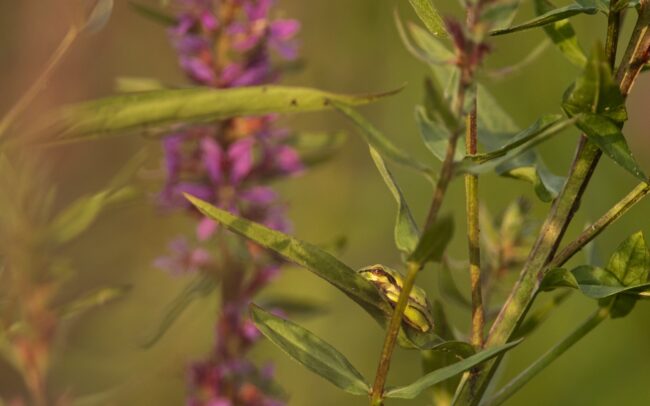
Hundreds or even thousands of european tree frogs have developed in the village of Sap, in a depression the size of a football field filled with water. It is a nice example of how the remains of former riverbeds can serve as miniature biodiversity hotspots even in the middle of a settlement. Its dominant plant is purple loosetrife, and its forest provides an ideal habitat for other species as well. Several species of bumblebees, bees, flies, hoverflies, dragonflies, and ladybugs stayed at the height of the plant's flowers. Lower down, its stems and leaves were occupied by tiny tree frogs, in exceptionally high density. A single plant species can provide excellent conditions for a multitude of animal species, which divide the space between them very nicely. And it is not bad to have such a wet habitat providing fresh microclimate in the middle of a village, during the drying climate.

The former rivers of Great Rye Island are isles in the agricultural landscape. These preserved river bends with reeds, bushes and trees are very important and species-rich habitats simply because of their huge size. Their right to exist is not in question, because they are worth a treasure. Their future is all the more uncertain because we are unable to see their value. While rivers used to be natural parts of the landscape, with which people could live together, the existence of their remains today is uncertain, as they are much more in the way of human interests. It is feared that the drying of the environment and the desire for arable land will sooner or later wipe them off the face of the earth. Great Rye Island, Slovakia.

Hundreds or even thousands of european tree frogs have developed in the village of Sap, in a depression the size of a football field filled with water. It is a nice example of how the remains of former riverbeds can serve as miniature biodiversity hotspots even in the middle of a settlement. Its dominant plant is purple loosetrife, and its forest provides an ideal habitat for other species as well. Several species of bumblebees, bees, flies, hoverflies, dragonflies, and ladybugs stayed at the height of the plant's flowers. Lower down, its stems and leaves were occupied by tiny tree frogs, in exceptionally high density. A single plant species can provide excellent conditions for a multitude of animal species, which divide the space between them very nicely. And it is not bad to have such a wet habitat providing fresh microclimate in the middle of a village, during the drying climate.

Although long dead because of human activity, which transform its habitat to agricultural land, the unearthly beauty of this ancient riverbed seems to defy time. Not even a half-kilometer perspective can picture the curves it once had. Lines of roe deer marks scratch its pastel colors. Great Rye Island, Slovakia

Without water, they meanderinging through Great Rye Island. Without a name, maybe they never had one. Without life, it was terminated by man some time ago. Formerly, now really dead branches of the Danube. In their place, grain crops, roads cross them, trees grow on them. But it was not possible to completely erase their tracks. Their silent message is intoxicating. They draw me into their tragic atmosphere.








